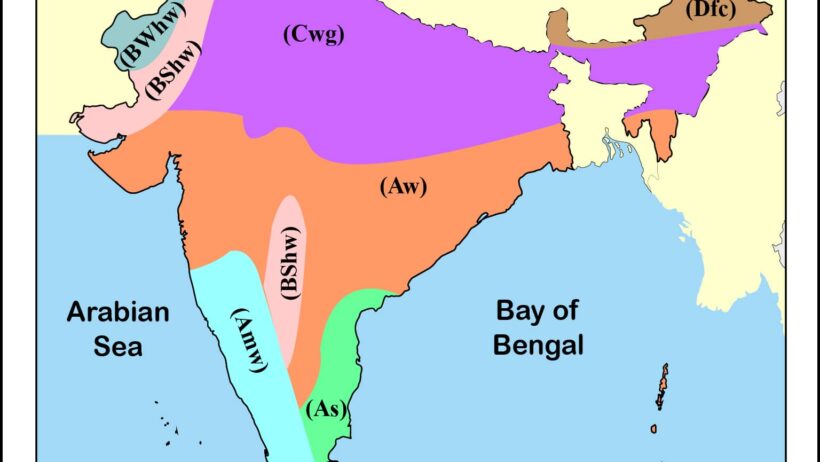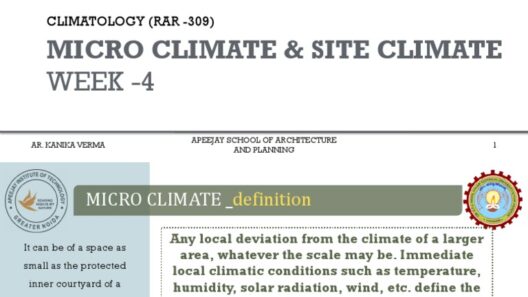India’s climate zones are akin to a vibrant tapestry, woven together with threads of diverse weather patterns, geographical variations, and ecological niches. Each zone possesses distinct characteristics, profoundly influencing the lives of the millions who inhabit the subcontinent. To comprehend the Indian climate is to embark on an exploration that spans the frigid heights of the Himalayas to the humid coasts of Kerala, navigating through arid deserts and lush green valleys along the way. This article aims to illuminate the astonishing diversity of India’s climate zones, examining how they shape the environment, agriculture, culture, and economy.
At the heart of India’s climatic identity lies the monsoonal system, a pivotal weather phenomenon that serves as the lifeblood for agriculture. The southwest monsoon, which typically brews from June to September, transforms the landscape from a parched tableau into a verdant paradise. The arrival of the monsoons can be likened to an artist’s brush sweeping across a canvas, drenching the earth with hues of green and infusing vitality into crops that sustain the populace. Critical for agrarian communities, this seasonal influx of moisture is not solely a matter of weather; it dictates livelihoods, cultural practices, and even regional economies. However, while monsoons may be a boon to some, they can also unleash wrathful torrents, leading to floods that devastate infrastructure and sow discord in affected communities. Thus, the duality of the monsoon encapsulates the intricate balance of nature—nurturing life while simultaneously wielding destructiveness.
As one traverses the geographical expanse of India, the stark contrast of climates becomes apparent. The northern Himalayan region, characterized by its frigid winters and cool summers, stands in stark juxtaposition to the scorching deserts of Rajasthan. The Himalayas, with their majestic peaks and deep valleys, experience significant snowfall and glacial formation, which subsequently influences river systems that feed the fertile plains below. This symbiotic relationship between altitude and hydrology is critical, as it sustains not only physical ecosystems but also the very essence of South Asian civilization. In essence, the Himalayas act as a formidable barrier, capturing monsoonal winds and orchestrating localized weather patterns that have shaped cultural and agricultural practices for millennia.
In stark contrast, the Thar Desert—often painted with the hues of yellow and ochre—exemplifies an environment governed by aridity. This region is characterized by extreme temperature fluctuations, where sun-drenched days yield to chilly nights. Inhabiting this seemingly hostile environment are resilient nomadic tribes and communities whose existence exemplifies adaptability and resourcefulness. Here, the scant rainfall is not merely a climatic statistic but a poignant reminder of nature’s mercurial temperament. Farmers cultivate hardy crops, such as millet and barley, which thrive in harsh conditions, epitomizing how life can flourish against the odds. The Thar Desert embodies a raw beauty, drawing adventurers and scholars alike to unravel its secrets and appreciate the indigenous knowledge that sustains its inhabitants.
Transitioning from the arid northwest, one finds a climate gradient leading towards the verdant Western Ghats. This UNESCO World Heritage site is a biodiversity hotspot teeming with flora and fauna, enriched by the heavy monsoonal rains that sweep over the mountains. The Ghats exemplify the phenomenon of orographic rainfall, a process by which moist air is forced upwards by mountainous terrain, resulting in lush rainforests that harbor an astonishing array of species. The interplay between diverse microclimates fosters ecosystems that are not only ecologically significant but also culturally rich. The Western Ghats symbolize a harmonious blend of geographical features and climatic conditions, creating sanctuaries for therapeutic herbs, endemic species, and vibrant local cultures intimately connected to the land.
Beyond the Western Ghats lies the coastal region, characterized by warm, tropical climates influenced by the Arabian Sea and the Bay of Bengal. The coastal states, including Tamil Nadu and Kerala, are defined by their sultry medium of humidity and monsoon rains, which yield bountiful harvests of coconut, rice, and spices. This climatic sanctum is not merely a backdrop for agricultural success; it cultivates a way of life inseparable from the rhythm of the sea and the seasons. Fishermen venture out at dawn, casting their nets into azure waters, guided by age-old traditions that harmonize with the moon’s phases. The rich cultural heritage of coastal India springs from the convergence of climatic stability and human ingenuity.
However, the tale of India’s climate is not without its challenges. The specter of climate change looms large, threatening the delicate balance of these varied ecosystems. Increasing temperatures, erratic rainfall patterns, and rising sea levels pose existential threats to vulnerable regions, particularly in the coastal belt and arid zones. The idyllic monsoons, which once arrived predictably, are becoming increasingly capricious, leading to agricultural distress—a precarious situation for a nation that relies heavily on farming. Addressing these challenges requires a concerted effort from policymakers, environmentalists, and the communities themselves. Sustainable practices must be prioritized, promoting resilience in agricultural systems and enhancing water conservation methods to mitigate the impacts of climate fluctuations.
In conclusion, India’s climate zones encapsulate the duality of nature’s benevolence and ferocity, painting a complex portrait of a land steeped in contrast and diversity. From the monsoonal embrace in the heart of the subcontinent to the harsh desert terrains and luxuriant coasts, every region narrates its own story of survival, adaptation, and human resilience. Understanding these climates is crucial—not only for appreciating India’s rich ecological and cultural mosaic but also for fostering a sustainable future in an era marked by climatic upheaval. As custodians of this extraordinary planet, it is incumbent upon us to cherish and protect the intricate web of life that thrives within India’s unique climate.








